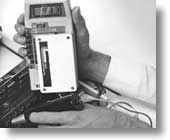|
 The Infrared Temperature Probe converts any standard multimeter info an Infrared Thermometer. The Infrared Thermometer is a passive sensor which receives and measures (heat) radiation from an object. The measured radiation is converted to an electrical signal which is displayed as the temperature of the object. The Infrared Temperature Probe converts any standard multimeter info an Infrared Thermometer. The Infrared Thermometer is a passive sensor which receives and measures (heat) radiation from an object. The measured radiation is converted to an electrical signal which is displayed as the temperature of the object.
Since temperature is measured without contact, there are several important advantages associated with this technique. Measurements are made rapidly (one second) so that thermal patterns and transient phenomena can be observed. Heat is not removed from the measured object so that the accuracy of the readings is assured. Moving objects, dangerous materials, and electrical components can be safely measured. The probe is ideal for non-destructive testing in the design of circuit boards.
The Model C-500 Infrared Temperature Probe is a portable, battery operated device for non-contact termperature measurement. It consists of a probe and a power supply unit. The power source is a single 9-volt alkaline battery.
Model C-500 is designed to "plug-in" to a standard Digital Multimeter and to generate a calibrated output of 1 millivolt/per degree. Using the 2 volt DC multimeter range, temperature readings are indicated in degrees F or C.
A three position switch, located on the power supply unit, is used to select power ON, power OFF, or battery check (BATT). In the "battery check" position, the meter should indicate approximately 0.9 volts for a fully charged (9 volt) battery. When the reading drops to 0.7 volts, the battery should be replaced.
For stable and safe operation the probe is designed to be held by the plastic body. Caution: Avoid contact of the front cone with warm objects for more than few seconds. Contact may cause the signal to drift upward several degrees. Also avoid prolonged readings of hot sources.
Measurements can be made from a distance of about .25 inch to 6 inches (0.6 cm to 15 cm) from the source. As the distance to the source is increased, the diameter of the measured area increases proportionally. At 3 inches (7.5 cm), the measured area is about 1 inch (2.5 cm) in diameter.
The effect of measuring at an angle, other than perpendicular to the source, is to slightly increase the measured area. For large uniform temperature source, the reading is unaffected by measurement angle and distance.
|

